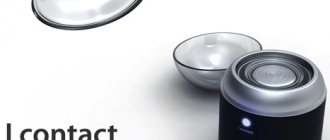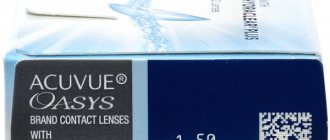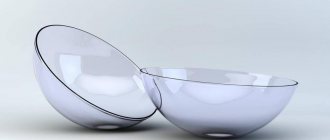A lens is an optical component that is made from a transparent material (optical glass or plastic) and has two refractive polished surfaces (flat or spherical). The oldest lens found by archaeologists in Nimrud is about 3,000 years old.
This suggests that people have been interested in optics since very ancient times and tried to use it to create various equipment that would help in everyday life. The Roman military used lenses to make fire while on the move, and Emperor Nero used a concave emerald as a remedy for his myopia.
Over time, optics became closely integrated into medicine, allowing the creation of vision correction devices such as eyepieces, glasses and contact lenses. In addition, the lenses themselves have become widespread in various high-precision technologies, which have made it possible to radically change a person’s ideas about the world around him.
What is a lens, what properties and features does it have?
Any lens in cross-section can be represented as two prisms placed on top of each other. Depending on which side they are in contact with each other, the optical effect of the lens will differ, as well as its type (convex or concave).
Let's look at what a lens is in more detail. For example, if you take a piece of ordinary
window glass, the edges of which are parallel, we will get a completely insignificant distortion of the visible image. That is, a ray of light entering the glass will be refracted, and after passing through the second edge and entering the air, it will return to its previous angle with a slight shift, which depends on the thickness of the glass. But if the planes of the glass are at an angle relative to each other (for example, as in a prism), then the ray, regardless of its angle, after hitting the given glass body will be refracted and exit at its base. This rule, which allows you to control the light flow, underlies all lenses. It is worth noting that all the features of lenses and optical devices based on them are studied by physics.
Definition
According to official terminology, a lens is a piece of transparent material with two surfaces that refract light rays. They are made from glass, plastic or other similar optical material. This term can also be applied to other phenomena, for example, an air lens, an underground lake lens, etc. But we will look at the optical ones. We've covered what lenses are, but how do they work? It's all about their surface. Simply put, one of their surfaces collects light, and the second, due to its shape, refracts it. Or vice versa. Also, both parties can participate in such a process at once: one, receiving, scatters, and the second collects into a bundle, etc. Everyone is probably familiar with magnifying lenses, especially boys, who in the summer, collecting light with them, turned it into a tiny and hot spot. And, by the way, an interesting fact: a similar method of starting a fire is mentioned in Aristophanes’ play “The Clouds,” dating back to 424 BC. e. The Roman Empire was also the first to use a method of vision correction using a lens: Emperor Nero watched gladiator fights through a concave emerald. He probably suffered from myopia. So now we know what lenses are.
What types of lenses are there in physics?
There are only two main types of lenses: concave and convex, also called diverging and converging. They allow you to split a beam of light or, conversely, concentrate it at one point at a certain focal length.
The convex lens has thin edges and a thick center, making it
appears as two prisms connected by their bases. This feature allows you to collect all rays of light coming from different angles to one point in the center. It was precisely these devices that the Romans used to start a fire, since focused rays of sunlight made it possible to create a very high temperature in a small area of a highly flammable object.
As for a concave (diverging) lens, its edges, on the contrary, are thicker than the middle. It can be thought of as two prisms connected at their vertices. Thanks to this, all rays that fall on such a lens will be scattered from the center to the edges. You can learn more about the wide variety of lenses in the article What lenses are there.
Fresnel lenses
Fresnel lenses consist of separate concentric ring-shaped segments adjacent to each other. They received their name in honor of the French physicist Augustin Fresnel, who first proposed and put into practice such a design in lighthouse lighting fixtures. The optical effect of such lenses is comparable to the effect of using traditional lenses of similar shape or curvature.
However, Fresnel lenses have a number of advantages, due to which they are widely used in lighting designs. In particular, they are much thinner and cheaper to manufacture compared to converging lenses. Designers Francisco Gomez Paz and Paolo Rizzatto did not fail to take advantage of these features when working on the bright and magical Luceplan Hope model range.
Made from lightweight, thin polycarbonate, Hope “sheets,” as Gomez Paz calls them, are nothing more than thin and large diffusion Fresnel lenses that create a magical, sparkling, and dimensional glow by being coated with a polycarbonate film textured with microprisms.
Paolo Rizzatto described the project this way: “Why have crystal chandeliers lost their relevance? Because they are too expensive, very difficult to handle and produce. We broke down the idea itself into its components and modernized each of them.”
And here is what his colleague said about this: “Several years ago our attention was attracted by the wonderful capabilities of Fresnel lenses. Their geometric features make it possible to obtain the same optical properties as conventional lenses, but on a completely flat surface of the petals.
However, the use of Fresnel lenses to create such unique products, combining excellent design with modern technological solutions, is still rare.
Such lenses are widely used in lighting scenes with spotlights, where they allow you to create an uneven light spot with soft edges, blending perfectly with the overall light composition. Nowadays, they have also become widespread in architectural lighting schemes, in cases where individual adjustment of the angle of light is required, when the distance between the illuminated object and the lamp can change.
The optical performance of a Fresnel lens is limited by the so-called chromatic aberration that forms at the junctions of its segments. Because of it, a rainbow border appears on the edges of images of objects. The fact that a lens feature that seemed like a disadvantage was turned into an advantage once again emphasizes the strength of the authors' innovative thought and their attitude to detail.
Lighthouse lighting design using Fresnel lenses. The image clearly shows the ring structure of the lens.
In what devices and for what are lenses used?
For a long time, people knew what a lens was. This detail was used in the first glasses, which appeared in the 1280s in Italy. Later, telescopes, telescopes, binoculars and many other devices were created, which consisted of many different lenses and made it possible to significantly expand the capabilities of the human eye. Microscopes were built on the same principles, which had a significant impact on the development of science as a whole.
The first televisions were equipped with huge lenses that magnified the image.
from miniature screens and made it possible to examine the picture in more detail. All video and photographic equipment, starting from the very first devices, are equipped with lenses. They are installed in the lens so that the operator or photographer can focus or zoom in/out of the image in the frame.
Most modern mobile phones have autofocus cameras, which use miniature lenses to take clear photos of objects that are a couple of centimeters or several kilometers away from the device's lens.
Don't forget about modern space telescopes (such as Hubble) and laboratory microscopes, which also have high-precision lenses. These devices give humanity the opportunity to see what was previously inaccessible to our vision. Thanks to them, we can study the world around us in more detail.
Meaning of the word lens
Examples of the use of the word lens in literature.
Viktor Abramov is still wearing glasses, not contact lenses, with the face of a typical smart guy, an excellent student-hooligan, a classic character in math school folklore.
In my last letters to Tarentum, I asked Agathocles to calculate the maximum radius of the lens at which this effect occurs, but, unfortunately, it turned out that Agathocles was killed during the last assault on Tarentum, and he is one of the last Tarentine mathematicians.
I am afraid that without the calculations of Agathocles and the slave assistants called upon to perform simple work, the creation of new lenses is a matter of a long time, and the equipment I have does not allow me to judge the existence of Phaethon’s satellites.
Having turned the watercolor of the Rainbow Palace in his hands, Avilov fixed the casual in a vertical position, and then at some distance behind the lenses of the casual he installed the watercolor.
By moving the watercolor to the sides in relation to the casual lenses, Avilov was able to see first one or the other wall in almost its entire volume!
Mavrodin sank into a chair, and then Vadim Sergeevich took a casual jacket out of the drawer, took Raduzhny’s watercolor, which Mavrodin also knew well, and suggested: “Try to look through these lenses.”
Avilov helped Mavrodin set the lenses at the desired angle, brought the watercolor to them, then began to move it to the sides.
These same psychocorrelative quantum fields of generations of what is happening in the senses group the ingredients of the Aspects of the general Image of the hologram into separate focuses - turbias of Fire, Light and Information - which are concentrated by the Lens of curvature of the Substance of Space and, filled with Soma Raj of the Outflows of Amrita Svarati, turn into corpuscles of elementary particles of Matter.
A thin layer of silver, opaque to visible light, quite freely transmits ultraviolet rays with a wavelength of 3000 angstroms, but these rays are blocked by glass - so a quartz lens was necessary.
It consists of a long wooden tube, forty-two feet long, into one end of which is inserted an achromatic lens six inches in diameter, with a focal length of forty-two feet, i.e.
This reflector and lens work like a heliostat, rotated by a clockwork mechanism to follow the sun, so that the reflected light always hits a second mirror in a dark tube, which in turn always reflects it through a slit onto the achromatic lens and diffraction grating.
If instead of one eye lens of a Kellner eyepiece you put two identical achromatic lenses, you will get one of Erfle’s wide-angle eyepieces.
The American Academy of Arts and Sciences in Boston gave him a large prize from the Rumfoord fund, which made it possible to build a large and powerful spectrograph with three huge prisms of dense flint, five inches on sides, and large achromatic lenses.
Through the lenses, Biron saw Jupiter, which foreshadowed the birth of new bishops, governors and bankers that night.
Miss Tick took out beads, a couple of feathers, a glass lens and two or three strips of colored paper.
Source: Maxim Moshkov library
What is a contact lens and why is it needed?
Contact lenses are small, clear lenses made from soft or
rigid materials that are intended to be worn directly on the eye for vision correction purposes. They were designed by Leonardo Da Vinci in 1508, but were not produced until 1888. Initially, lenses were made only from hard materials, but over time, new polymers were synthesized, which made it possible to create soft lenses that were practically imperceptible during daily use.
If you want to purchase contact lenses, then read the article How to choose lenses to learn more about this device.
Areas of use
With the discovery of the possibility of changing the wavelength of light through lenses (image magnification), humanity quickly appreciated it. It all started with simple telescopes and telescopes. And the latter have long been an indicator of the status of a ship captain or explorer, since they cost a lot of money and were often encrusted with precious stones and metals. And later, the first microscopes made it possible to lift the curtain of the macrocosm. True, some modern models operating according to the probing type are almost devoid of lenses. But they allow you to build three-dimensional and raster images of small objects. Various devices with lenses are also an integral part of the modern world: they are found in the cameras of mobile phones, photo and video cameras, even ordinary door peepholes contain lenses. But they do not use the method of magnification, but rather the scattering of light, thanks to which a small hole allows you to see the entire landing. Also, when asking what optical lenses are, one cannot help but mention glasses. This simple device was invented in the Middle Ages and has changed little, but it makes life much easier for people with visual impairments. Their first prototypes were used back in Ancient Rome, but then they were simply flat pieces of glass with a convex or concave shape, which were rarely used, for example, for reading or for studying distant objects.
Contact
But what are contact lenses? The principle of their operation is the same as in ordinary ones, but the size is much smaller. They are made of soft plastic and are placed directly on the cornea of the eye. Despite their advantages over regular glasses, they have not completely replaced them, as the inventors predicted. Such lenses are more difficult to put on, they require frequent care, and wearing them for a long time tires and irritates the eyes. In addition, their service life is shorter than regular glasses, and the price is sometimes higher.










